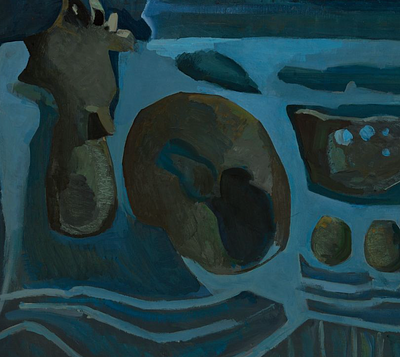WILFREDO LAM (Sagua La Grande, Cuba, 1902 - Paris, 1982). Untitled, 1966. Ink on paper.
Lot 94
About Seller
Setdart Auction House
Carrer Aragó 346
Barcelona
Spain
Setdart Subastas was born in 2004 and is currently the first online art auction in Spain with solidity, prestige and reliability guaranteed by our more than 60,000 users. Setdart has a young, dynamic and enterprising team ready to successfully manage the purchase and sale of art works through custom...Read more
Categories
Estimate:
EUR€7,000 - EUR€8,000
$7,526.88 - $8,602.15
Absentee vs Live bid
Two ways to bid:
- Leave a max absentee bid and the platform will bid on your behalf up to your maximum bid during the live auction.
- Bid live during the auction and your bids will be submitted real-time to the auctioneer.
Bid Increments
| Price | Bid Increment |
|---|---|
| EUR€0 | EUR€10 |
| EUR€200 | EUR€25 |
| EUR€500 | EUR€50 |
| EUR€1,000 | EUR€100 |
| EUR€3,000 | EUR€200 |
| EUR€5,000 | EUR€500 |
| EUR€10,000 | EUR€1,000 |
| EUR€20,000 | EUR€2,000 |
| EUR€50,000 | EUR€5,000 |
About Auction
By Setdart Auction House
Jul 27, 2021
Set Reminder
2021-07-27 08:00:00
2021-07-27 08:00:00
America/New_York
Bidsquare
Bidsquare : CONTEMPORARY AND ACTUAL ART
https://www.bidsquare.com/auctions/setdart-auction-house/contemporary-and-actual-art-7261
Setdart Auction House sofia@setdart.com
Setdart Auction House sofia@setdart.com
- Lot Description
WILFREDO LAM (Sagua La Grande, Cuba, 1902 - Paris, 1982). Untitled, 1966. Ink on paper. Attached certificate issued by the Wilfredo Lam Foundation. Signed in the upper left corner. Dated and located (Paris), in the lower right area. Measurements: 29.5 x 40 cm; 48 x 59 cm (frame). In this work one can appreciate the artistic language developed by Wilfredo Lam, translated into a series of characters and aesthetic elements, which became his own iconography. During the forties Lam began an artistic activity based on the roots of a people that, in the painter's opinion, should recover its dignity. In this way, the autochthonous references were fused with the formal language learned in Europe to produce works where the characters of the Yoruba pantheon that would populate a large part of his later production already appeared. Wifredo Lam was trained in Havana, where he studied at the School of Fine Arts. He made his individual debut in the early 1920s, with an exhibition at the Salon of the Association of Painters and Sculptors of the Cuban capital. In 1923 he moved to Madrid, with a scholarship from the City Council of Sagua La Grande, where he continued his training in the workshop of Fernando Alvarez de Sotomayor, director of the Prado Museum and recognized for having been Salvador Dali's teacher. At the same time, he attended the Academia Libre del Pasaje de la Alhambra, and visited the Prado, where his preferences leaned towards the work of Bosch, Brueghel and Goya. Little by little, his painting assumed a modern language that combined a geometrical structure with a certain surrealist vein. In 1938 he traveled to Paris, with a letter of recommendation for Picasso written by Manolo Hugué. Lam, who had had the opportunity to attend the Picasso exhibition held in Madrid in 1936, defined this experience as "a shock". In 1939 he had his first personal exhibition in Paris, with Pierre Loeb. During World War II Lam remained in the Caribbean, in contact with representatives of the avant-garde such as Masson and Breton, who, fascinated by the Cuban's pictorial work, asked him to illustrate his poem "Fata Morgana" (1940). Back in Cuba, Lam began an artistic activity based on the roots of a people who, in the painter's opinion, should recover their dignity. In this way, the autochthonous references were fused with the formal language learned in Europe to produce works where the characters of the Yoruba pantheon that would populate a large part of his later production already appeared. In the second half of the forties, Lam alternated his residence between Cuba, New York and Paris, where he settled in 1952. His international prestige grew progressively, and he held periodic exhibitions in galleries such as the Pierre Matisse Gallery in New York. He traveled intensely during the following years and, in 1960, he settled in Albisola Mare, on the Italian coast. In 1961 he received the Guggenheim International Prize, and between 1966 and 1967 multiple retrospectives of his work were held at the Kunsthalle in Basel, the Kestner-Gessellschaft in Hannover, the Stedelijk Museum in Amsterdam, the Museum of Modern Art in Stockholm and the Palais des Beaux-Arts in Brussels. Wifredo Lam is represented at the Guggenheim and MoMA in New York, the Museo Patio Herreriano in Valladolid, the Tate Gallery in London and the Museo Thyssen-Bornemisza, among others.
- Shipping Info
-
In-house shipping available. Please inquire at admin@setdart.com.
-
- Buyer's Premium



 EUR
EUR CAD
CAD AUD
AUD GBP
GBP MXN
MXN HKD
HKD CNY
CNY MYR
MYR SEK
SEK SGD
SGD CHF
CHF THB
THB
















